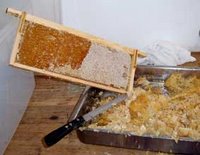 The honey harvest is in!
The honey harvest is in!The advance careful planning went out of the window, as usual. I spoke with the local GP beekeeper and booked a time to use his centrifuge. During our conversation he said that I should definitely take out any filled frames in the more recent 2nd super. I had only added this (brand new and self assembled, with sparkly new frames and wax foundation) at the very beginning of August, just before we went on holiday. On subsequent hive inspections in Mid August and early September the bees had hardly touched it, so I was not expecting to extract anything from it .
Any way, on the advice of the good doctor I opened the hive and to my great surprise found the 2nd super about 60% full. The bees were seriously unimpressed at being robbed again (I had not had the time or chance to put the Porter excluders in) and they put up a fearful din. My smoker ran out of smoke, 2 bees got into my trouser pocket and another inside the veil where they did their duty. Ooowwww! Next time I will remember that time spent planning is time well spent!

I took all the frames over to his extraction room (this makes him sound more like a dentist than a doctor) and started decapping the frames using an old bread knife. This is a messy job and surprisingly hard work. In no time I had cramp in my hands. When I spoke to some apiarists at the Quy Country Fair they said they had used a hair drier to melt of the caps and it works very well, once you have realised that you do not want to melt holes through the frame; a light touch is clearly required but it sounds much quicker.
The second lot of frames were thinner and strangely had significant proportion of the honey in a crystalised form, which therefore did not extract. The honey smelled and tasted different too. Doc says it is probably from Ivy and not so sweet or flavoursome. The bees will reprocess the crystalised comb when I put the frames back in the super.
The centrifuge is simple and effective but you have to hold it down with all your weight when it gets up to speed, or it can shake itself to bits. A slight difference in weight of honey in the frames gets magnified enormously when the centrifuge gets up to speed. Its elementary physics really.
The honey splats out onto the walls of the centrifuge walls and drips down to the bottom, with all sorts of bits of wax, dead earwigs, bees and propylis etc. We then lifted the whole thing onto a table and drained the honey through a double sieve (coarse and then fine) into a bucket.
The great part of it all is that you do not need to clean anything. Just leave it out in the garden and in no time at all the bees have found it and over the next day or two they will clean it up completely. If there is a lot of runny honey in a bucket, put in some hay or straw so the bees do not drown.
So now the honey is in the kitchen keeping warm and settling. Any impurities float to the top.
I am ordering my honey jars and about to design the labels. I think that we will get about 25-30 lbs.
The children all asked for home made bread and honey for breakfast. This is a first. Great excitement!
And they have taken a sticky frame of honey to school for "Show and Tell". The teacher has been learning what she can from the internet.
I just hope they do not leave it lying about or the school will be filled with 100s of bees, and I will be in the Dog House!
Labels: Beekeeping

0 Comments:
Post a Comment
Subscribe to Post Comments [Atom]
<< Home